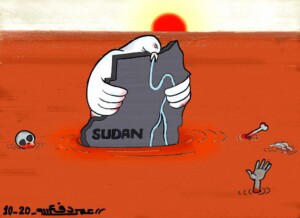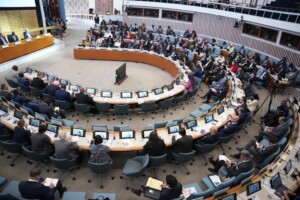Sudan OCHA bulletin 3: Yellow fever vaccination campaign reaches over 8 million
The Ministry of Health, in collaboration with international organisations, launched a large-scale yellow fever vaccination campaign reaching over 8 million people in Blue Nile, Sennar, and El Gezira states in March this year. The Central Emergency Response Fund (CERF) has released $26.4 million to respond to urgent life-saving humanitarian needs in Sudan. Fuel and cash shortages continue to impact humanitarian operations in the country, and cereal prices remain high despite bumper harvest, according to the latest bulletin of the UN Office for the Coordination of Humanitarian Affairs (OCHA) in Sudan.

The Ministry of Health, in collaboration with international organisations, launched a large-scale yellow fever vaccination campaign reaching over 8 million people in Blue Nile, Sennar, and El Gezira states in March this year. The Central Emergency Response Fund (CERF) has released $26.4 million to respond to urgent life-saving humanitarian needs in Sudan. Fuel and cash shortages continue to impact humanitarian operations in the country, and cereal prices remain high despite bumper harvest, according to the latest bulletin of the UN Office for the Coordination of Humanitarian Affairs (OCHA) in Sudan.
The Ministry of Health, in collaboration with the World Health Organization (WHO), Gavi, the Vaccine Alliance, and the UN Children’s Agency (UNICEF) launched a large-scale yellow fever vaccination campaign reaching over 8 million people between 9 months and 60 years in Blue Nile, Sennar, and El Gezira states between 10-29 March, the bulletin reads.
Sudan plans to complement the yellow fever mass campaigns and ensure long-term protection with the introduction of yellow fever vaccinations into routine immunizations in the coming months. “We acknowledge the commitment of the health authorities in Sudan to avail cash and fuel during this economic crisis to ensure that Sudanese people, especially children, are protected with a quality vaccine, which would contribute to health security and making the world safer,” said Dr Naeema El Gaseer, WHO Representative in Sudan.
Prof Babikir Kaballo, Undersecretary of the Federal Ministry of Health in Sudan, said that “The current campaign represents one of the final phases in the ministry’s efforts to protect the entire nation against yellow fever. This phase of the campaign covered Blue Nile, El Gezira, and Sennar states. In coming months, the remaining states of Khartoum, Northern and River Nile will also be covered, completing the he protection of the entire Sudan population.”
CERF provides $26.4 million for life-saving humanitarian actions
The $26.4 million includes funds for food security and livelihoods, nutrition, health, as well as water, sanitation and hygiene sectors, targeting an estimated 805,000 people in 19 localities across seven states during six months, OCHA Sudan states.
This CERF allocation will be complemented by the ongoing Sudan Humanitarian Fund (SHF) Standard Allocation of $21 million, which will jointly target the prioritised localities ensuring strategic synergies with the CERF funds. While CERF will focus on pipeline commodities, SHF will be allocated more to service delivery to vulnerable populations.
Effect of fuel and cash shortages on humanitarian operations in Sudan
Humanitarian operations in various parts of the country continue to be affected by the fuel and cash shortages in the country.
Cash shortages, reported since November 2018, continue to delay the implementation of refugee assistance projects in all refugee locations in Sudan, according to UNHCR. The situation is compounded by rising inflation and ongoing fuel shortages. Water system functionality has been the hardest hit, with generators at pumping stations unable to run due to the lack of diesel fuel.
UNHCR has been trying different delivery mechanisms to address the liquidity issue, including ATM and delivering cash.
 Displaced leaders in Hamidiya camp -which hosts about 50,000 people- in Zalingei, capital of Central Darfur, reported shortages in the water supply in the camp since January due to shortages of diesel needed to run the water pumping stations. About 50 per cent of the water supply in Hamidiya camp for displaced people comes from fuel-operated water pumping stations; 48 per cent comes from three solar water pumping systems; and 2 per cent comes from eight hand pumps.
Displaced leaders in Hamidiya camp -which hosts about 50,000 people- in Zalingei, capital of Central Darfur, reported shortages in the water supply in the camp since January due to shortages of diesel needed to run the water pumping stations. About 50 per cent of the water supply in Hamidiya camp for displaced people comes from fuel-operated water pumping stations; 48 per cent comes from three solar water pumping systems; and 2 per cent comes from eight hand pumps.
In other places in Central Darfur, crops of displaced people withered because they could not irrigate their farms as they are unable to run their water pumps because of diesel shortages.
WFP faces funding shortages
The World Food Programme (WFP) is facing severe funding shortages for its emergency cash transfer programmes, which benefits approximately 350,000 vulnerable displaced and refugees, and is funded through June 2019. These shortages are affecting WFP’s ability to provide emergency food assistance and nutrition services to people affected by shocks—including displaced and people affected by conflict and natural disasters.
Despite commitments made at the Grand Bargain, donor earmarking and interest in supporting cash-based programming has resulted in funding gaps in essential activities, including emergency cash transfers and the prevention of moderate and acute malnutrition.
Without increased financial support for these activities, WFP will be forced to scale back cash programming, reduce coverage and transfer values, and will need to shift to the provision of in-kind food as a last resort.
Bumper harvest amid high food prices
The 2018 cropping season has recorded a bumper harvest as a result of abundant and well-distributed seasonal rains and due to increased plantings encouraged by an early onset of seasonal rains, and by very high prevailing market prices, according to the latest issue of the Sudan Country Brief by the Food and Agriculture Organization (FAO) Global Information and Early Warning System (GIEWS).
The findings of the Government-led annual Crop and Food Supply Assessment Mission (CFSAM) indicate that the aggregate cereal production in Sudan is estimated at 8.2 million tonnes, 57 per cent up from the reduced 2017 output and 30 per cent above the previous five-year average.
The most significant increase in planted and harvested area was recorded in the traditional rain-fed agricultural areas in Darfur, where security improvements allowed a substantial number of displaced people to return to their home areas and to engage in agricultural activities, according to the GIEWS/FAO report.
Cereal prices high despite bumper harvest
Increasing prices of agricultural inputs and fuel, due to foreign currency shortages, devaluation of the local currency and high inflation have severely raised agricultural production costs, especially in semi-mechanized rainfed areas and in irrigated schemes. The Central Bureau of Statistics (CBS) of Sudan reported that the inflation rate reached almost 73 per cent in December, then sharply reduced to 43 per cent in January 2019 and was at 44 per cent in February 2019.
FEWS NET reported in its January-September 2019 Food Security Outlook for Sudan that this decline in inflation rate is attributed to decreased food and beverage prices and is therefore considered highly debatable.
In addition, some large-scale traders are holding onto their stocks, as this is regarded as a more reliable form of saving than keeping sums of fast devaluating Sudanese Pounds and widespread shortage of cash, which is hindering consumer market purchases, GIEWS/FAO update reported.
Despite the bumper cereal harvest, the availability of cereals in the market is low and except for limited declines in millet prices in January and February, prices of cereals continued the upward trend that began in late 2017. In February, prices of sorghum, millet and wheat grain were at near record to record levels in most monitored markets and up to twice their year-earlier values, the report said.

Over 847,000 South Sudanese refugees registered in Sudan
The number of South Sudanese refugees in Sudan stands at 847,923 people, of whom 8,835 arrived in 2019, reports the UN Refugee Agency (UNHCR) in their 31 March update. As of end March, UNHCR and Sudan’s Commission of Refugees (COR) registered 407,583 refugees.
The majority of arrivals in 2019 have taken refuge in East Darfur (5,418), followed by West Kordofan (1,825), South Darfur (806), South Kordofan (435) and White Nile (351) States.
Cash-based assistance programme for East Darfur refugees
WFP has introduced its first cash-based food assistance programme for refugees in Sudan, through which 15,147 South Sudanese refugees (4,578 households) in El Nimir and El Ferdows camps in East Darfur received hybrid-multipurpose cash assistance. The programme provides beneficiaries with a monthly total of $21 each, intended for food and non-food needs as well as accompanying in-kind cereal rations. The combined package of in-kind food and cash has reduced refugees’ need to sell their food rations to cover their other basic needs and dietary preferences, enhancing their self-reliance and dignity while improving nutrition, food security outcomes and access to other basic non-food items.
Efforts to tackle GBV and sexual, reproductive health concerns in Darfur
Between 10-25 March, the UN Populations Fund (UNFPA) and its implementing partners in North and West Darfur trained 60 social workers on gender-based violence (GBV) aspects, and the provision of psychosocial and referral support to victims of GBV reaching 3,500 targeted community members through this training.
In addition, UNFPA established five confidential corners in the two Darfur states.
According to the most recent report by the UN Secretary-General on the AU-UN Hybrid Operation in Darfur (Unamid), there are still gaps in the management of GBV cases, including the need for psychosocial support and community awareness-raising in Darfur. The SG’s report said that in Central Darfur, protection issues included killings, abductions, sexual and gender-based violence, including conflict-related sexual violence, robbery, assaults and harassment, in particular in the areas of Golo, Neirtiti and Zalingei.
Sexual and gender-based violence, including conflict-related sexual violence, remains a serious concern for women in the greater Jebel Marra area, according to the SG’s report.
UNHAS flies to new destinations in Sudan
In 2019, the UN Humanitarian Air Service (UNHAS) in Sudan has introduced new and additional locations to ensure coverage across a range of areas. These new locations lie in North Darfur, South Kordofan, Blue Nile state, and Kassala.
With a fleet of six airframes, UNHAS Sudan transported 22,544 passengers, 86 metric tons of light cargo and carried out 12 medical and/or security evacuations in 2018. A total of 63 NGOs and 17 UN agencies benefited from its reliable and safe flights to 39 locations across the country to serve vulnerable populations who are in urgent need of assistance.











 and then
and then